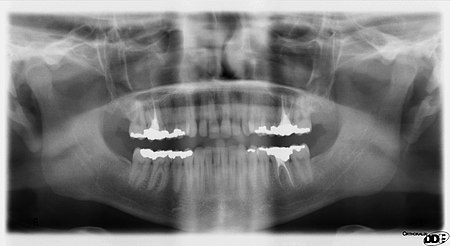You brush, you floss, you’ve started scraping your tongue, and you come in for regular check ups. Perhaps you’ve been wondering why you need to get dental x-rays on top of your excellent oral care routine. Are dental x-rays really necessary for your oral health? The answer is yes: dental x-rays are a useful diagnostic tool for Dr. Brunacini and Dr. Karagiorgos and help them detect damage and disease not visible during a general exam. This month we spoke with Dr. Karagiorgos about why dental x-rays are an important part of your oral health care.
Dental X-rays provide dentists the opportunity to identify any potential problems in the mouth. What exactly are you looking for when you review X-rays?
Dr. Karagiorgos: X-rays are a very important diagnostic tool that allow dentists to see more of people’s teeth than what we can see in the mouth with just magnifying lenses and a headlight. With x-rays we can see things like tooth decay between adjacent teeth, we can see if there are any potential problems under the gums, in the bone or in the roots of the teeth.
Are there any types of x-rays that hurt or require special preparation or protection?
Dr. Karagiorgos: Dental x-rays themselves don’t hurt per se. There are conditions in some patients that can make it a little more difficult for those patients to take x-rays. For example, patients with a limited ability to open their mouth, patients that have a very strong gag reflex or some that have larger bony protrusions in their mouths. X-rays have evolved and improved quite a bit over the years. At Falmouth Dental Arts, we have state-of-the-art digital x-ray sensors that allow us to take and immediately see diagnostic images in high resolution, using far less radiation than the previous generation film x-rays.
What are the most serious diseases or conditions that you can prevent thanks to taking regular X-rays?
Dr. Karagiorgos: X-rays can help us routinely detect things like dental decay and tooth infections. X-rays can also help us diagnose very serious general health problems. We can see pathology in the bone like invasive cysts or cancerous tumors. Panoramic films and 3D cone beam x-rays that rotate around the head are commonly used to evaluate the jaw joints or to see wisdom teeth coming in. These x-rays with expanded fields of view can also help us see things like restricted airways, salivary blockages or even calcifications in the circulatory system of the neck which can put patients at increased risk of stroke.
What has been the most surprising thing that you have seen on Dental X-rays?
Dr. Karagiorgos: I just got back from a dental convention where a dentist presented the latest imaging technology. He presented us a slide showing x-rays taken on a 6 year old boy. His images showed what looked like a round metal object in the boy’s left sinus. The x-ray image was of such great quality that we were able to make out George Washington’s bust! It turns out that without anyone’s knowledge, the boy had lodged a quarter so deep into his nose that it ended up in the boy’s maxillary sinus. That was pretty surprising to see, but even more surprising was the very next slide.
It was an x-ray of the sinus of the boy’s 8-year-old brother. Apparently, the brother had a lego brick in the exact same location!
Are there any medical conditions or situations where you advise patients to not undergo x-rays?
Dr. Karagiorgos: Typically, no. Dental X-rays are of lower doses of radiation. They are considered generally safe. That said, we specifically try to limit x-ray exposure to expectant women. We are always weighing the risks and benefits of every treatment, and this includes taking x-rays.
As dentists, we practice the ALARA principle with radiation. ALARA stands for “as low as reasonably achievable”. This principle means that even if it is a small dose of radiation, if there is no direct benefit, you should try to avoid it.
Thank you, Dr. Karagiorgos!
When was the last time you had x-rays of your teeth taken? We recommend routine Bitewings x-rays for adults every 1-2 years depending on decay history, gum health, and dry mouth. For children and teens we recommend it every year. Major films are recommended every 3-5 years for both adults and children to monitor growth and development as well as periodontal health. Call our office today at 207.781.5900 to make your appointment!
*Image courtesy of www.wikipedia.org

